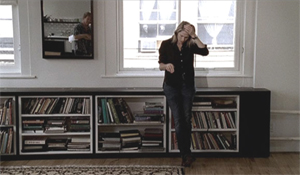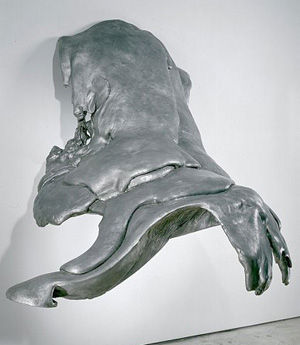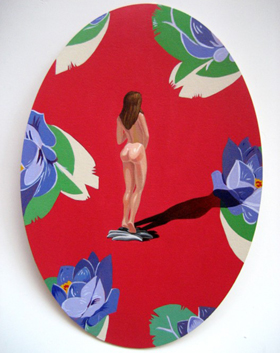Taking the Bad with the Good
John Haberin New York City
Bad Girls: From Louise Bourgeois to Anna Gaskell
The problem with good girls is that they are waiting to fall. The problem with bad girls is that they are waiting to be redeemed.
Artists have been playing with those stereotypes for a long time now. Marcia Tucker made waves with a group show on the theme back in 1994, in fact. Feminism and Postmodernism just made them a lot scarier and a lot more fun. The only trick lies in telling the roles apart. 
For the late spring and summer of 2007, quite a few women artists have done a particular fine job of scrambling the roles. They also force the viewer to piece together the entire story from scratch. Louise Bourgeois had been doing so for sixty years when she and Lynda Benglis started to bring dark sexual fantasies out of Surrealism and into the post-industrial age, and now they share a space. Margaret Murphy likes to pretend she is painting only bad girls, but you and I know better. And Anna Gaskell presents psychological turning points as true confessions, but with the artist, the viewer, and the narrator all asking questions.
Making a splash
Louise Bourgeois was working with Fernand Léger when Lynda Benglis was five years old. Yet each gained attention in New York, Bourgeois in painting, at almost exactly the same time—and both will have pride of place in a 2008 survey of feminist art from the 1970s, "WACK!" For each, but especially Louise Bourgeois, it took some creepy sculpture and a formidable personality, and the same exclusive gallery now handles them both. That sounds like a self-serving excuse for a summer show, and so it is. Fortunately, it also promises a good story and some very good art. Now guess which one played the bad girl first?
In 1970 Benglis had not turned thirty, while Bourgeois had had work in the Museum of Modern Art for longer than Jackson Pollock. The first might have seemed more infamous than famous, thanks to sculpture resembling congealed lava and an appearance in Artforum brandishing a dildo, short hair, dark glasses, bright lipstick, a nasty smile, and little else. The other had languished on the periphery of fame. In retrospect, both had already come into their own, thanks to the same three things—feminism, talent, and the troubled aftermath of Minimalism. Benglis offered a counterpart to Richard Serra's Splash Pieces, in materials layered on the floor or tied like ribbons on the walls. Bourgeois's caged Spider at Dia:Beacon suggests Surrealism sprung to life as a black widow, but with renewed resonance from Minimalism's factory scale, industrial parts, and invasion of the viewer's space.
Several recent shows have looked at the same years of adjustment, including "High Times, Hard Times" and "Summer of Love." Benglis in fact appeared in both with much the same poured latex, first as abstract sculpture without fine art materials, then as psychedelic floor covering. Now a gallery presents the artists instead as Minimalism's feminist unconscious. It sees them both as tactile and fluid, and it sees those qualities as the recovery of a woman's bodily experience in living and making art. Rough streams of metal ooze to the floor, gather in heaps, or hang from the ceiling by a wire thread. They give the lie to the thought that a lead pile can grow only as fast as teaspoons of sperm.
 Benglis also has what look like narrow abstract paintings, but the spattered color has congealed. Bourgeois contributes a sculpted amoeba or two. Benglis shapes a two-headed penis into a smile, while Bourgeois sculpts a whole row of penises, each seemingly sliced through by a metal foreskin. It should come as no surprise to one who has seen her 1982 portrait by Robert Mapplethorpe, cradling a roughly sculpted phallus under her arm like a shotgun. Correspondences like these will make anyone, at least any male critic of contemporary art, feel even more sheepish. This kind of feminism also makes for some pretty classy sculpture.
Benglis also has what look like narrow abstract paintings, but the spattered color has congealed. Bourgeois contributes a sculpted amoeba or two. Benglis shapes a two-headed penis into a smile, while Bourgeois sculpts a whole row of penises, each seemingly sliced through by a metal foreskin. It should come as no surprise to one who has seen her 1982 portrait by Robert Mapplethorpe, cradling a roughly sculpted phallus under her arm like a shotgun. Correspondences like these will make anyone, at least any male critic of contemporary art, feel even more sheepish. This kind of feminism also makes for some pretty classy sculpture.
Like most huge piles of goo, however, this story covers up a few salient points. For one thing, the two artists come at Minimalism from different directions in time. Bourgeois is finding a hard ground for her imaginings, an industrial reality for biomorphic sculpture, while Benglis is telling serial form and industrial material to let go. The repeated boxes of Louise Nevelson and Eva Hesse offer very much the same contrast. Besides, neither artist fits so easily into the exhibition's gynecological certainties—even if Nevelson drawings included women. Bourgeois is threatening them, often with sexually ambiguous reference points, and Benglis, I like to think, is having fun with them.
Bourgeois's primitive, surging, bisexual masses still look so frightening. Benglis's bisexual self-portrait and funky carpeting, meanwhile, still look funny. Which, then, does that make the bad girl? You can take your pick, but the show contributes something regardless, especially once one gets past its thesis. At some point, one can tell the artists apart again, and one has gained again in perception. More often than not, Bourgeois's forms threaten to rise up, while Benglis's threaten to keep tumbling down. Art can still defy gravity, but the 1970s changed how.
Some girls
The good girls have had quite a run for it recently. True, Nathalie Djurberg keeps inviting art's bad boys and girls into the sweetest of fairy tales, Clarity Haynes bares a bad girl's sagging flesh, and a group show boasts of "The Brand New Heavies," meaning black. Yet Tracey Moffatt plays dress-up with nothing but role models—the more, the merrier. And the trouble with "Global Feminisms" at the Brooklyn Museum was that it seemed to find only good girls. Its artists merely nurture together, suffer together, and cheer each other on.
Of course, the real problem with both good and bad girls is that they amount to male fantasies. Each plot has an unspoken hero, perhaps even me. In its earliest versions, the girls even offer him a choice. Raphael painted a dream of two woman, one only slightly more angelic than the other, although legend prefers to dwell on Raphael's mistress. Veronese painted a man fleeing from vice to virtue, and I feel sorriest for the woman he left behind. But if the story goes back a long time, it came into its own with the novel, with Hollywood—and, to trust Margaret Murphy, with a souvenir store in your very neighborhood.
Murphy does not exactly celebrate good girls and bad girls, but she sure loves seeking them out. "Third-wave" feminism made it okay to look for one's inner bad girl, just when post-feminism made it (marginally) acceptable again to talk of women as girls, period. Carla Gannis recently based her film noir creations on Jezebel, and Anne Collier has invoked the gaze of Laura Mars, but Murphy goes back to the real kitsch role models, in Victorian drawing rooms. She surrounds her solo figures in the ovals then common in painting, given a touch of the third dimension and set amid the rectangular frame. Some backgrounds draw on heavily patterned wallpaper, while others settle for unfashionable wall colors, but all may have you looking for a sconce to either side. The women themselves run the gamut, but Murphy reserves the greatest temptations for her good girls—the Madonna or the proper schoolgirl, give or take her flowing hair and short skirt.
Murphy paints quickly, and the loose shadows help sex things up, too. No doubt a truly eminent Victorian would have labored over fine detail, hard anatomy, cold surfaces, and the trompe l'oeil of one medium within another. She is not painting from life anyway or even from storybooks. She has hunted down every one of the girls, good and bad alike, as cheap figurines. Many, she says, she found in Amsterdam, which I recall has a notorious red-light district. If the hunt signals an obsession, the Victorian oval could also serve for a mirror, just as girls like these have served women as role models. 
The series in fact describes a whole sequence of mirroring. Painting copies molded plastic, which copies fine art, which copies life, which copies cliché—which in turn is ripe for a woman's appropriation. As in Plato's theory of art or, for that matter, Jean Baudrillard's "simulacra," reality becomes more degraded with each successive copy. The poses, with their faces just barely turned away and with their variations on a theme, may suggest Cindy Sherman and her Untitled Film Stills, but never imaginary. The combination of bare legs, faceless women, and consumer goods may suggest the collage photographs of Laurie Simmons, but without the Pop irony or stern admonition. The recycling of cheap artifice as art may suggest Jeff Koons, but the pleasure lies in the irony and the kitsch rather than in its being kitsch.
Murphy never lets good and bad girls get too fanciful, too admonitory, too accepting, or too knowing. Perhaps this has its costs, too. An engagement with Victorian art does not have the familiarity or the shock of Sherman or Simmons. On the other hand, it is intelligent, and it has its real temptations—for both the artist and the viewer. (Ironically, her gallery's summer show, of Karen Marston's paintings after The Wizard of Oz, the bad girl has already melted, and the good girl appears only as her red slippers.) As for me, I am holding out for the schoolgirl.
Whose pictures?
After all that, someone has to ask who is judging, just as on reality TV. When I think of video, I think of just that—or perhaps walking behind a thick curtain and stumbling too long in the dark. Not this time, for only a partition separates each of Anna Gaskell's three videos, and their muffled voices overlap. One has to stand at just the right spot, below a pair of speakers, to hear any of them clearly, and even then one will never know for sure what they say or who is voting whom off the island. The exhibition title seems to have given up in frustration: "Paint Your Own Pictures."
Her own pictures make it hard to resist trying. In the longest and largest, Acting Lessons, Gaskell herself tells a story restlessly, as if compelled to. It might involve a lonely encounter, an angry breakup, or simply a character study, but either way it feels like a turning point for her. The furniture and mirror behind her underscore the intimacy. So does the way her slim figure leans back and her long leg curls up on the bureau. Perhaps she needs to put herself at ease, too.
Someone, you see, is watching—someone else, I mean. The acting teacher's voice interrupts her narrative, and his reflection darts in and out of the mirror. He makes her start over several times, to bring her improvisation closer to a lost moment. He plays the director and Gaskell the actor, even while she as filmmaker is simultaneously directing him. Something of the same confusion applies to the viewer's gaze. Exactly who is directing and scrutinizing whom?
Lorna Simpson has multiplied voices before on video, and Stan Douglas has carried a proliferation of points of view worthy of Rashômon to geometric proportions. Gaskell, too, gets at concerns for self-assertion, self-discovery, personal memory, and unreliable narrators. However, she also asks how one accepts responsibility for one's narratives. As with Simpson, that may offer a space for female responsibility. In two briefer videos, it extends to the choices and vulnerability of a child. And in all three works, the psychological intimacy carries a violent or sexual charge.
Vermilion (That's All I Remember) interviews two children, a boy and a girl. Separated by two channels and a gap in time, the twins nonetheless share the same space, with the sea behind them and a common horizon line. They, too, recall a disturbing encounter, although they cannot agree on exactly what, and they never get to who it involved and what it meant for them. The emotional resonance seems to arise as much from their correcting and, perhaps, directing each other as from the event itself. The third video runs from start to finish without interruption, but it has even more voices and more reflections. Gaskell even calls it For Mirror.
For Mirror presents a wooded landscape, both reasonably idyllic and appropriate for a teenage horror flick that Sue de Beer might have enjoyed. A female form moves through it, and then one returns to the contemplation of nature. Gaskell showed several kids the part involving a person and asked them to describe what they saw, and they supply the soundtrack. One could easily imagine, however, that they are describing what is happening in real time, so that the "lady vanishing" acquires a purpose, a present, or a future. Again a sequence of voices at once recalls, restarts, and continues a story. If I am to trust its title, the installation lies open to new pictures even now, and who knows what kind of girl they will describe when they grow up?

Louise Bourgeois and Lynda Benglis shared Cheim & Read through August 31, 2007, Margaret Murphy's "Good Girls/Bad Girls" ran at Cheryl McGinnis through June 16, and Anna Gaskell's "Paint Your Own Pictures" ran at Yvon Lambert through May 26. A related review rounds up solo shows over the years of Lynda Benglis, including a New Museum retrospective.




